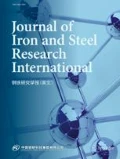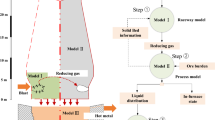Abstract
Corex is an alternative ironmaking process and raceway is one of the important areas to maintain the stability of the furnace. The raceway parameters are well established for blast furnace operation. But for Corex process, it has not yet been established and optimized. Thus, a mathematical model was developed to determine various raceway parameters such as RAFT (raceway adiabatic flame temperature), tuyere gas velocity and kinetic energy. The model provides an idea about the raceway geometry, zone temperature and kinetic energy accumulated in tuyere gas. Besides, all the raceway parameters have been analyzed to find out their effects on the Corex process. It is found that RAFT influences the gasification reaction kinetics and higher RAFT generates more CO in reduction gas, which improves the metallisation degree of the DRI in shaft. It is also found that increased gas velocity and kinetic energy generate more fines and demand more coke to maintain char bed permeability. High coke rate increases the production cost and lowers the production of hot metal.
Similar content being viewed by others
References
Lee Seung-cheol, Shin Myung-kyun, Joo Sanghoon, et al. A Development of Computer Model for Simulating the Transport Phenomena for COREX Melter-Gasifier [J]. ISIJ International, 1999, 39(4): 319.
Lee Seung-cheol, Shin Myung-kyun, Joo Sanghoon, et al. The Effects of Operational Parameters on the Transport Phenomena in COREX Melter-Gasifier [J]. ISIJ International, 2000, 40 (11): 1073.
Subrata Pal, Ashok Kumar Lahiri. Mathematical Model of Corex Melter Gasifier: Part I Steady-State Model [J]. Metallurgical and Materials Transactions, 2003, 34B(1): 103.
Subrata Pal, Ashok Kumar Lahiri. Mathematical Model of Corex Melter Gasifier: Part II Dynamic Model [J]. Metallurgical and Materials Transactions, 2003, 34B(1): 115.
Prachethan Kumar P, Gupta D, Naha T K, et al. Factors Affecting Fuel Rate in Corex Process [J], Ironmaking and Steelmaking, 2006, 33(4): 293.
Prachethan Kumar P, Gupta P K, Ranjan M. Operating Experiences With Corex and Blast Furnace at JSW Steel Ltd [J]. Ironmaking and Steelmaking, 2008, 35(4): 260.
Austin P R, Nogami H, Yagi J. Analysis of Actual Blast Furnace Operations and Evaluation of Static Liquid Holdup Effects by the Four Fluid Model [J]. ISIJ International, 1998, 38(3): 246.
Aoki H, Nogami H, Tsuge H, et al. Simulation of Transport Phenomena Around the Raceway Zone in the Blast Furnace With and Without Pulverized Coal Injection [J]. ISIJ International, 1993, 33(6): 646.
Biswas Anil K. Principles of Blast Furnace Ironmaking Theory and Practice [M]. Calcutta: SBA Publications, 1984.
Author information
Authors and Affiliations
Corresponding author
Rights and permissions
About this article
Cite this article
Barman, S.C., Mrunmaya, K.P. & Ranjan, M. Mathematical Model Development of Raceway Parameters and Their Effects on Corex Process. J. Iron Steel Res. Int. 18, 20–24 (2011). https://doi.org/10.1016/S1006-706X(11)60059-9
Received:
Published:
Issue Date:
DOI: https://doi.org/10.1016/S1006-706X(11)60059-9




